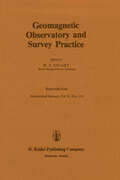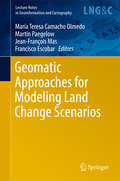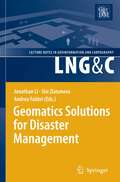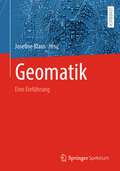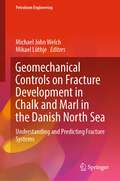- Table View
- List View
Geomagnetic Observatory and Survey Practice
by W. F. StuartThis issue is a collection of the papers read at the 'Workshop on Geomagnetic Observatory and Survey Practice' held during the XIVth General Assembly of IUGG (the International Union of Geology and Geophysics) in Hamburg, August 1983, sponsored by Division V of the International Association of Geomagnetism and Aeronomy (IAGA). The papers represent a snapshot taken at a very important time in the history of Geomagnetism and of the sciences which depend on measurements of one kind or another of the Earth's magnetic field. Research science now demands a much greater amount of information to be prepared and immediately made available to the scientific user. Experimental measurements are now required to be reduced, selected and made ready as information which can be recorded as data on magnetic tape in the form required for direct incorporation into the analytical programmes whiCh individual researchers run on digital computers. Computing has reduced the lead time between when observations are made and when they are required by researchers. Many scientific programmes, particularly those related to Solar-terrestrial geophysics, need data to be analysed as near as possible to the time it is recorded. In Geomagnetism these pressures apply to field variations where satellite based geophysical experiments require high resolution of the fine structure of external disturbance fields, and also to field mapping on a global and local scale where the demand for increased accuracy calls for better absolute observations and more frequent surveys.
Geomagnetically Induced Currents from the Sun to the Power Grid (Geophysical Monograph Series #246)
by Jennifer L. Gannon Andrei Swidinsky Zhonghua XuAn introduction to geomagnetic storms and the hazards they pose at the Earth’s surface Geomagnetic storms are a type of space weather event that can create Geomagnetically Induced Currents (GICs) which, once they reach Earth’s surface, can interfere with power grids and transport infrastructure. Understanding the characteristics and impacts of GICs requires scientific insights from solar physics, magnetospheric physics, aeronomy, and ionospheric physics, as well as geophysics and power engineering. Geomagnetically Induced Currents from the Sun to the Power Grid is a practical introduction for researchers and practitioners that provides tools and techniques from across these disciplines. Volume highlights include: Analysis of causes of geomagnetic storms that create GICs Data and methods used to analyze and forecast GIC hazard GIC impacts on the infrastructure of the bulk power system Analysis techniques used in different areas of GIC research New methods to validate and predict GICs in transmission systems
Geomagnetically Induced Currents from the Sun to the Power Grid (Geophysical Monograph Series #246)
by Andrei Swidinsky Jennifer L. Gannon Zhonghua XuAn introduction to geomagnetic storms and the hazards they pose at the Earth’s surface Geomagnetic storms are a type of space weather event that can create Geomagnetically Induced Currents (GICs) which, once they reach Earth’s surface, can interfere with power grids and transport infrastructure. Understanding the characteristics and impacts of GICs requires scientific insights from solar physics, magnetospheric physics, aeronomy, and ionospheric physics, as well as geophysics and power engineering. Geomagnetically Induced Currents from the Sun to the Power Grid is a practical introduction for researchers and practitioners that provides tools and techniques from across these disciplines. Volume highlights include: Analysis of causes of geomagnetic storms that create GICs Data and methods used to analyze and forecast GIC hazard GIC impacts on the infrastructure of the bulk power system Analysis techniques used in different areas of GIC research New methods to validate and predict GICs in transmission systems
Geomagnetics for Aeronautical Safety: A Case Study in and around the Balkans (Nato Security through Science Series C:)
by Jean L. Rasson Todor DelipetrovThis book shows how the science of geomagnetism contributes to effective use of the magnetic compass for navigation. The book uses techniques from Geology, Instrument science, Magnetism, Chaos theory and Potential Fields applied to the geomagnetic landscape of the Balkan region and surroundings. The editors and contributors have assembled a comprehensive review of measurement, analysis, mapping and forecasting of magnetic declination in support of aeronautical safety.
Geomagnetism: Solid Earth and Upper Atmosphere Perspectives
by Nathani BasavaiahWith the awareness that the Earth has a magnetic field, its mathematical description, discovery of remanent magnetisation in rocks and discovery of the periodic reversals of the geomagnetic field polarity, geomagnetism within geophysics became an interesting field of study. This is primarily due to advances in measurement technology and improved understanding of the magnetic field and its fluctuations in the geospace. Several important aspects of solid Earth geomagnetism are elaborated in the book. The first six chapters cover the basics of magnetism, magnetic minerals, biomagnetics, instrumentation and the behavior of geomagnetic field, while the rest of the book is devoted to practical applications with carefully selected examples and illustrations. Well-written and easy to read, the book vividly describes modern techniques in the subject matter covered, adequately supported by graphical explanations for complex mathematical concepts.
Geomagnetism and Palaeomagnetism (Nato Science Series C: #261)
by F. J. Lowes D. W. Collinson J. H. Parry S. K. Runcorn D. C. Tozer A. SowardThis volume presents lectures given at the NATO Advanced Study Institute held 11-22 April 1988 at Newcastle upon Tyne, England. The aim of the Institute was to improve the interaction between workers in observational geomagnetism (using historical data) and archaeo- and palaeo-magnetism (using the remanent magnetization of man-made artefacts and of natural sediments and rocks) and those trying to interpret the data in terms of mechanisms inside or outside the Earth, particularly those developing dynamo theories of the field. The material discussed ranged from magnetic bacteria swimming round a circle in a few seconds, the effect of El Nino, through secular variation with time scales of tens to thousands of years and the'mechanics of individual field reversals and excursions (aborted reversals?) to possible modulation of average reversal frequency on the hundred million year time scale. Many members of the Physics Department helped with the organization, and we are most grateful to them, and in particular to Anne Codling for her very many contributions. We also gratefully acknowledge the painstaking work of Aileen Dryburgh and Lynn Whiteford in so carefully typing the manuscript.
Geomathematics: Theoretical Foundations, Applications And Future Developments (Quantitative Geology and Geostatistics #18)
by Frits AgterbergThis book provides a wealth of geomathematical case history studies performed by the author during his career at the Ministry of Natural Resources Canada, Geological Survey of Canada (NRCan-GSC). Several of the techniques newly developed by the author and colleagues that are described in this book have become widely adopted, not only for further research by geomathematical colleagues, but by government organizations and industry worldwide. These include Weights-of-Evidence modelling, mineral resource estimation technology, trend surface analysis, automatic stratigraphic correlation and nonlinear geochemical exploration methods. The author has developed maximum likelihood methodology and spline-fitting techniques for the construction of the international numerical geologic timescale. He has introduced the application of new theory of fractals and multi fractals in the geostatistical evaluation of regional mineral resources and ore reserves and to study the spatial distribution of metals in rocks. The book also contains sections deemed important by the author but that have not been widely adopted because they require further research. These include the geometry of preferred orientations of contours and edge effects on maps, time series analysis of Quaternary retreating ice sheet related sedimentary data, estimation of first and last appearances of fossil taxa from frequency distributions of their observed first and last occurrences, tectonic reactivation along pre-existing schistosity planes in fold belts, use of the grouped jackknife method for bias reduction in geometrical extrapolations and new applications of the theory of permanent, volume-independent frequency distributions.
Geomatic Approaches for Modeling Land Change Scenarios: A Review And Comparison Of Modeling Techniques (Lecture Notes in Geoinformation and Cartography)
by María Teresa Camacho Olmedo Martin Paegelow Jean-François Mas Francisco EscobarThis book provides a detailed overview of the concepts, techniques, applications, and methodological approaches involved in land use and cover change (LUCC) modeling, also known simply as land change modeling. More than 40 international experts in this field have participated in this book, which illustrates recent advances in LUCC modeling with examples from North and South America, the Middle East, and Europe. Given the broad range of geomatic approaches available, it helps readers select the approach that best meets their needs. The book is structured into five parts preceded by a foreword written by Roger White and a general introduction. Part I consists of four chapters, each of which focuses on a specific stage in the modeling process: calibration, simulation, validation, and scenarios. It presents and explains the fundamental ideas and concepts underlying LUCC modeling. This is complemented by a comparative analysis of the selected software packages, practically applied in various case studies in Part II and Part III. Part II discusses recently proposed methodological developments that have enhanced modeling procedures and results while Part III offers case studies as well as interesting, innovative methodological proposals. Part IV revises different fundamental techniques used in LUCC modeling and finally Part V describes the best-known software packages used in the applications presented in Parts II and III.
Geomatic Methods for the Analysis of Data in the Earth Sciences (Lecture Notes in Earth Sciences #95)
by Athanasios Dermanis Armin Grün Fernando SansòGeomatics is an amalgam of methods, algorithms and practices in handling data referred to the Earth by informatic tools. This book is an attempt to identify and rationally organize the statistical-mathematical methods which are common in many fields where geomatics is applied, like geodesy, geophysics and, in particular, the field of inverse problems and image analysis as it enters into photogrammetry and remote sensing.These lecture notes aim at creating a bridge between people working in different disciplines and making them aware of a common methodological basis.
Geomatics Engineering: A Practical Guide to Project Design
by Clement OgajaTraditionally, land surveyors experience years of struggle as they encounter the complexities of project planning and design processes in the course of professional employment or practice. Giving beginners a leg up and working professionals added experience, Geomatics Engineering: A Practical Guide to Project Design provides a practical guide to co
Geomatics Solutions for Disaster Management (Lecture Notes in Geoinformation and Cartography)
by Jonathan Li Sisi Zlatanova Andrea FabbriEffective utilization of satellite positioning, remote sensing, and GIS in disaster monitoring and management requires research and development in numerous areas, including data collection, information extraction and analysis, data standardization, organizational and legal aspects of sharing of remote sensing information. This book provides a solid overview of what is being developed in the risk prevention and disaster management sector.
Geomatik: Eine Einführung
by Josefine KlausWas ist eine Mercatorabbildung? Wie berechnet man Koordinaten? Wie funktioniert ein Geoinformationssystem? Diese und viele weitere Fragen beantwortet „Geomatik - Eine Einführung“ und bietet damit zum ersten Mal die theoretischen Grundlagen der Ausbildung zur/zum Geomatiker:in in einem Werk.Folgende Themen werden auf der Grundlage des bundesweit einheitlichen Rahmenlehrplans der Berufsausbildung behandelt:Organisation des Vermessungswesen Erfassung, Bearbeitung und Präsentation von Geodaten Verwaltung von GeodatenGrundlagen des Web- und Printdesigns Selbstständige Entwicklung von GeoproduktenDie Inhalte werden ergänzt durch ein auf die Prüfungen angepasstes Lernangebot und zahlreiche weiterführende Informationsquellen. Dadurch entsteht ein umfassendes und zeitgemäßes Handbuch für den Berufsschulunterricht und zur Prüfungsvorbereitung im Bereich der Geoinformatik, Vermessung und Kartographie. Aus einer modernen, digitalen Wissensvermittlung sind die visuellen und kartenbasierten Ansätze der Geomatik nicht mehr wegzudenken. Die in diesem Buch angebotenen Informationen ermöglichen es angehenden Geomatiker:innen und Interessierten selbstständig eigene Geoprodukte zu erstellen.
GeoMeasurements by Pulsing TDR Cables and Probes
by Kevin M O'Connor Charles H DowdingGeoMeasurements by Pulsing TDR Cables and Probes examines Time Domain Reflectometry (TDR) research and provides information on its use as a robust, reliable, and economical production tool.Common uses for TDR technology include telecommunications and power industries, but the text examines applications such as measurement of moisture of unsaturated soils; detection of fluids for leak and pollution; measurement of water levels for hydrological purposes; measurement of water pressures beneath dams; and deformation and stability monitoring of mines, slopes, and structures.Chapters discuss:basic physics of signal generation, transmission, and attenuation along the coaxial cableprobe designs and procedures for calibration as well as the variation in probe responses to changes in water content and soil mineralogyvariations in waveform characteristics associated with cable, deformation, cable calibration, and installation techniques for metallic cables in rockseveral cases demonstrating the use of TDR cables in soil as well as weathered and soft rocka rationale for the use of compliant cable in soilthe use of metallic cable (MTDR) and optical fiber (OTDR) to monitor response of structuressensor/transducer components, connections from the sensors to the TDR pulser/sampler, and system control methodsavailable software for transmission and analysis of TDR signatures The diverse interest and terminology within the TDR community tends to obscure commonalities and the universal physical principles underlying the technology. The authors seek to crystallize the basic principles among the seemingly divergent specialties using TDR technology in geomaterials. By examining varied experiences, GeoMeasurements by Pulsing TDR Cables and Probes provides a synergistic text necessary to unify the field.
GeoMeasurements by Pulsing TDR Cables and Probes
by Kevin M O'Connor Charles H DowdingGeoMeasurements by Pulsing TDR Cables and Probes examines Time Domain Reflectometry (TDR) research and provides information on its use as a robust, reliable, and economical production tool.Common uses for TDR technology include telecommunications and power industries, but the text examines applications such as measurement of moisture of unsaturated soils; detection of fluids for leak and pollution; measurement of water levels for hydrological purposes; measurement of water pressures beneath dams; and deformation and stability monitoring of mines, slopes, and structures.Chapters discuss:basic physics of signal generation, transmission, and attenuation along the coaxial cableprobe designs and procedures for calibration as well as the variation in probe responses to changes in water content and soil mineralogyvariations in waveform characteristics associated with cable, deformation, cable calibration, and installation techniques for metallic cables in rockseveral cases demonstrating the use of TDR cables in soil as well as weathered and soft rocka rationale for the use of compliant cable in soilthe use of metallic cable (MTDR) and optical fiber (OTDR) to monitor response of structuressensor/transducer components, connections from the sensors to the TDR pulser/sampler, and system control methodsavailable software for transmission and analysis of TDR signatures The diverse interest and terminology within the TDR community tends to obscure commonalities and the universal physical principles underlying the technology. The authors seek to crystallize the basic principles among the seemingly divergent specialties using TDR technology in geomaterials. By examining varied experiences, GeoMeasurements by Pulsing TDR Cables and Probes provides a synergistic text necessary to unify the field.
Geomechanical Aspects of Operation of Underground Gas Storage (Springer Geology)
by Vladimir Karev Yuri KovalenkoThis book is devoted to the most important and urgent problems arising during the operation of underground gas storage facilities (UGS) and associated with the destruction of the reservoir and sand production into the wells. UGS facilities play a special role in ensuring high reliability of stable and guaranteed gas supplies to consumers. However, despite many years of experience in UGS well operation, there is still no sufficiently substantiated geomechanical model of reservoir failure and a mathematical description of the processes occurring in the reservoir-well system, taking into account the peculiarities of the mechanical behavior of reservoir rocks during cyclic injection and extraction of gas. As a result, there are no reliable criteria for establishing a rational regime for the operation of an UGS wells in conditions of a possible destruction of reservoir rocks. Further development of underground gas storage direction requires the introduction of innovative technologies that can be used both in the design of new UGS facilities and to extend the safe and efficient operation of existing underground gas storage facilities. To solve these problems, the most promising technologies, taking into account their efficiency, relatively low cost and environmental safety, are those based on the geomechanical approach.The book is addressed to specialists in the development and operation of underground gas storage facilities, as well as specialists in geomechanics of oil and gas fields. It can be useful for students and graduate students studying in the speciality "Development of oil and gas fields".
Geomechanical Behaviors of Bimrocks
by Wang YuThis book is intended as a reference book for advanced graduate students and research engineers in block-in-matrix rocks (bimrocks) or soil and rock mixtures (SRMs) or rock and soil aggregate (RSA). Bimrocks are complex formations characterized by competent rock inclusions floating in a weaker matrix. Typical types of bimrocks include a series of mixed geological or engineering masses such as mélanges, fault rocks, coarse pyroclastic rocks, breccias, sheared serpentines, and waste dump mixture. Bimrock is especially different from the general soil and rock material, and the detection of the damage and fracture is still wide open to innovative research. Globally, there is a widespread interest in investigating the geomechanical behaviors of bimrocks, such as deformation and strength characteristics, damage and fracture evolution, and stability prediction of bimrock construction. However, the meso-structural factors control the whole mechanical properties of bimrocks; the source of the macroscopic deformation phenomenon is the meso-structural changes. Therefore, evaluation of the mesoscopic physical and mechanical properties, together with advanced testing technique, is an attractive research topic in rock mechanics. As a result, comprehensive macroscopic and mesoscopic experimental investigations should be conducted to reveal the damage and fracturing mechanical behaviors of bimrocks. The readers of this work can gain new insights into the meso-structural changes of bimrocks subjected to different stress paths. This book is expected to improve the understanding of the mesoscopic damage and fracturing mechanisms of bimrocks, and can be helpful to predict the stability of rock structures where rock mass is subjected to complex loading conditions.
Geomechanical Behaviors of Bimrocks
by Wang YuThis book is intended as a reference book for advanced graduate students and research engineers in block-in-matrix rocks (bimrocks) or soil and rock mixtures (SRMs) or rock and soil aggregate (RSA). Bimrocks are complex formations characterized by competent rock inclusions floating in a weaker matrix. Typical types of bimrocks include a series of mixed geological or engineering masses such as mélanges, fault rocks, coarse pyroclastic rocks, breccias, sheared serpentines, and waste dump mixture. Bimrock is especially different from the general soil and rock material, and the detection of the damage and fracture is still wide open to innovative research. Globally, there is a widespread interest in investigating the geomechanical behaviors of bimrocks, such as deformation and strength characteristics, damage and fracture evolution, and stability prediction of bimrock construction. However, the meso-structural factors control the whole mechanical properties of bimrocks; the source of the macroscopic deformation phenomenon is the meso-structural changes. Therefore, evaluation of the mesoscopic physical and mechanical properties, together with advanced testing technique, is an attractive research topic in rock mechanics. As a result, comprehensive macroscopic and mesoscopic experimental investigations should be conducted to reveal the damage and fracturing mechanical behaviors of bimrocks. The readers of this work can gain new insights into the meso-structural changes of bimrocks subjected to different stress paths. This book is expected to improve the understanding of the mesoscopic damage and fracturing mechanisms of bimrocks, and can be helpful to predict the stability of rock structures where rock mass is subjected to complex loading conditions.
Geomechanical Controls on Fracture Development in Chalk and Marl in the Danish North Sea: Understanding and Predicting Fracture Systems (Petroleum Engineering)
by Michael John Welch Mikael LüthjeThis book summarizes new discoveries on fracturing in chalk. Based on studies on the Danish North Sea, this book shows how observations from outcrop analogues, core and seismic data can be used to characterize the density, distribution and geometry of natural fractures in chalk and marl. Laboratory experiments on chalk samples reveal the controls on the geomechanical properties of chalk and thus on the growth of natural fractures. Finally, various modeling techniques are employed to investigate the mechanical deformation in the chalk structures of the Danish North Sea and to predict fracture distribution and geometry in the subsurface. An understanding of fracture density, distribution and geometry is essential for planning efficient fluid extraction or injection strategies and CO2 sequestration. This book provides the necessary knowledge.
Geomechanical Processes and Their Assessment in the Rock Massifs in Central Kazakhstan (SpringerBriefs in Earth Sciences)
by Khaini-Kamal Kassymkanova Gulnara Jangulova Gulnura Issanova Venera Turekhanova Yermek ZhalgasbekovThis book focuses on the mineral deposits from the mining complex of Kazakhstan, including copper ores from the Nikolayevsky and Shemonaikhinsky open-pit quarries, and from the Kazchrome and Konyrat mines in Balkhash. This study assesses the geomechanical conditions of the rock massive, as well as strengthening and reinforcing processes. It develops methods for their assessment and provides detailed instructions on applying the methods. The book also summarizes the latest research and developments in formulating cement solutions to reinforce slopes and suppress dust on the roads of the quarry. The book’s overarching goal is to promote geological and mining engineering conditions that ensure the ecologically safe development of the mineral resource fields. Given its scope, the book will be of interest to mining engineers, researchers, and students in a broad range of geomechanical, geodesic, mining and environmental fields.
Geomechanical Processes during Underground Mining: School of Underground Mining 2012
by Volodymyr Bondarenko Mykhaylo Illiashov Genadiy Pivnyak Iryna Kovalevs'KaThis volume deals with economic aspects of mining companies development strategies, various mineral deposits development techniques, imitational modeling of mine workings with rock massif, methane extraction technologies during coal mining, geomechanical processes during plow mining, mining transport importance for mineral extraction, massif
Geomechanics and Fluidodynamics: With Applications to Reservoir Engineering (Theory and Applications of Transport in Porous Media #8)
by Victor N. NikolaevskiyThis monograph is based on subsurface hydrodynamics and applied geomechanics and places them in a unifying framework. It focuses on the understanding of physical and mechanical properties of geomaterials by presenting mathematical models of deformation and fracture with related experiments.
Geomechanics and Geodynamics of Rock Masses: Selected Papers from the 2018 European Rock Mechanics Symposium
by Vladimir LitvinenkoGeomechanics and Geodynamics of Rock Masses – Selected Papers contains selected contributions from EUROCK 2018, the 2018 International Symposium of the International Society for Rock Mechanics (ISRM 2018, Saint Petersburg, Russia, 22—26 May 2018). Dedicated to recent advances and achievements in the fields of geomechanics and geotechnology, the book will be of interest to researchers and professionals involved in the various branches of rock mechanics and rock engineering. EUROCK 2018, organized by the Saint Petersburg Mining University, is a continuation of the successful series of ISRM symposia in Europe, which began in 1992 in Chester, UK.
Geomechanics and Geodynamics of Rock Masses: Selected Papers from the 2018 European Rock Mechanics Symposium
by Vladimir LitvinenkoGeomechanics and Geodynamics of Rock Masses – Selected Papers contains selected contributions from EUROCK 2018, the 2018 International Symposium of the International Society for Rock Mechanics (ISRM 2018, Saint Petersburg, Russia, 22—26 May 2018). Dedicated to recent advances and achievements in the fields of geomechanics and geotechnology, the book will be of interest to researchers and professionals involved in the various branches of rock mechanics and rock engineering. EUROCK 2018, organized by the Saint Petersburg Mining University, is a continuation of the successful series of ISRM symposia in Europe, which began in 1992 in Chester, UK.
Geomechanics and Geodynamics of Rock Masses: Proceedings of the 2018 European Rock Mechanics Symposium
by Vladimir LitvinenkoGeomechanics and Geodynamics of Rock Masses contains contributions presented at EUROCK 2018, the 2018 International Symposium of the International Society for Rock Mechanics (ISRM 2018, Saint Petersburg, Russia, 22-26 May 2018). Dedicated to recent advances and achievements in the fields of geomechanics and geotechnology, the main topics of the book include: - Physical and mechanical properties of fractured rock (laboratory testing and rock properties, field measurements and site investigations)- Geophysics in rock mechanics- Rock mass strength and failure- Nonlinear problems in rock mechanics- Effect of joint water on the behavior of rock foundation- Numerical modeling and back analysis- Mineral resources development: methods and rock mechanics problems- Rock mechanics and underground construction in mining, hydropower industry and civil engineering- Rock mechanics in petroleum engineering- Geodynamics and monitoring of rock mass behavior- Risks and hazards- Geomechanics of technogenic deposits Geomechanics and Geodynamics of Rock Masses will be of interest to researchers and professionals involved in the various branches of rock mechanics and rock engineering. EUROCK 2018, organized by the Saint Petersburg Mining University, is a continuation of the successful series of ISRM symposia in Europe, which began in 1992 in Chester, UK.
Geomechanics and Geodynamics of Rock Masses: Proceedings of the 2018 European Rock Mechanics Symposium
by Vladimir LitvinenkoGeomechanics and Geodynamics of Rock Masses contains contributions presented at EUROCK 2018, the 2018 International Symposium of the International Society for Rock Mechanics (ISRM 2018, Saint Petersburg, Russia, 22-26 May 2018). Dedicated to recent advances and achievements in the fields of geomechanics and geotechnology, the main topics of the book include: - Physical and mechanical properties of fractured rock (laboratory testing and rock properties, field measurements and site investigations)- Geophysics in rock mechanics- Rock mass strength and failure- Nonlinear problems in rock mechanics- Effect of joint water on the behavior of rock foundation- Numerical modeling and back analysis- Mineral resources development: methods and rock mechanics problems- Rock mechanics and underground construction in mining, hydropower industry and civil engineering- Rock mechanics in petroleum engineering- Geodynamics and monitoring of rock mass behavior- Risks and hazards- Geomechanics of technogenic deposits Geomechanics and Geodynamics of Rock Masses will be of interest to researchers and professionals involved in the various branches of rock mechanics and rock engineering. EUROCK 2018, organized by the Saint Petersburg Mining University, is a continuation of the successful series of ISRM symposia in Europe, which began in 1992 in Chester, UK.
